When he launched Windows, Bill Gates dreamt of a world where every home had a computer that was running Windows. At that time, nobody believed it was possible. Yet, within two decades, he almost achieved his dream. By 1999, 90% of the personal computers in the world ran on Windows. Thus, he transformed a two-man operation into a multi-billion dollar business. In this biography of Bill Gates, read about how Bill Gates began from nothing and built a multi-billion dollar business. Find out how he took the existing computer technology, modified it to suit a specific market, and then dominated that market by promoting innovatively.
Early Life
Birth
William Henry Gates III was born in Seattle, Washington, on October 28th, 1955. His father, William Henry Gates II, was a successful lawyer. His mother, Mary Maxwell, was a teacher. Together, they had three children – William and his two sisters. Since his name was William Henry Gates III, his grandmother nicknamed him ‘Trey,’ which meant three.
How did William Henry Gates III become Bill Gates?
There is a tradition that originated in the middle ages, which is called letter swapping. Probably because hard consonants are easier to pronounce than soft ones, the first letter of a name is often replaced by another letter. Thus, a person named Will was often nicknamed Bill. For instance, King William III of England was often referred to as King Billy, by his subjects in the 17th century. For the same reason, Bill became the short form of William, and Bill Gates became the short form of William Henry Gates. Thus, William Henry Gates III came to be known as Bill Gates. Interestingly, his father had the same nickname too.
Childhood
As a kid, Bill Gates’ favorite games were Monopoly and Risk (where the goal is world domination). Since childhood, Bill has had a habit of reading business magazines. Once, while reading such a magazine when he was in middle school, he had a dream – to open a company. It was a big dream for a small child, but a dream that he would later realize.
When he was a child, Bill displayed disruptive behavior. He started questioning his parents’ decisions. He did not think that their rules were logical and, at times, refused to follow them. This often led to conflict between him and his parents. Moreover, he had some fixed ideas about certain things. He didn’t like it when people confronted him about them. Once, Mary, Bill Gates’ mother, had trouble getting him to the dinner table. So, she asked him what he was doing. But Gates, suddenly annoyed, shot back at her, saying, “I’m thinking, mother. Have you ever tried thinking?” So, alarmed at Gates’ behavior, his parents took him to a psychologist when he was twelve years old.
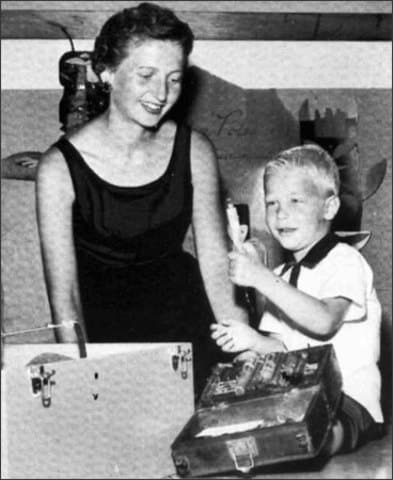
Bill Gates, as a kid, with his mother – Picture credits
The psychologist advised Gates not to challenge his parents’ decisions as he wouldn’t prove anything. At the same time, he advised Gates’ parents to give Gates more freedom and free will. Bill took the advice of the psychologist and gradually stopped questioning his parents’ decisions. Besides helping Bill’s parents, the psychologist’s advice helped Bill too, because, as he stopped questioning his parents, they became more supportive of his interest in programming too.
Interest in programming
First exposure to computer
Bill Gates’ first exposure to computers came when he was studying at the Lakeside School in Seattle. In those days, the computer was a very costly gadget. A moderate price for a computer at that time was $1 million. It was not something that many schools could afford. But fortunately for Bill, a local company had purchased a computer. The mothers’ club at his school purchased time slots to use the computer, much like we pay money to use a computer for an hour in an internet cafe. Thanks to them, Bill got the opportunity to use a computer for the very first time. The primitive machine caught his attention immediately, and he was enthralled by the possibilities it offered. He was just thirteen years at that time and was in eighth grade.
Bill Gates took an interest in programming the computer. So, he joined hands with Paul Gardner Allen, who was two years his senior but had similar interests as him. Together, they started skipping classes and working in the school’s computer room instead. Sometimes, the school was even supportive of Bill Gates, letting him skip Mathematics classes to pursue his interest.
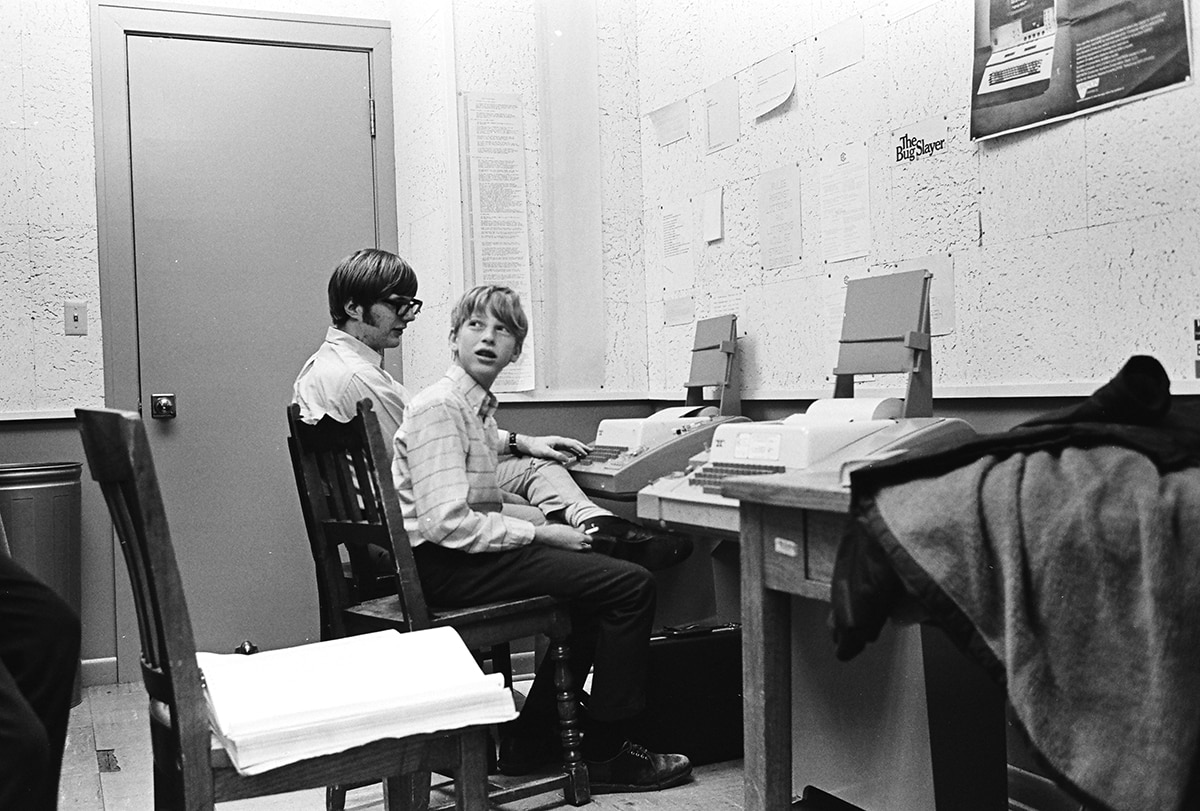
A Picture of Paul Allen and Bill Gates (right) at Lakeside school in 1970 – By Bruce Burgess – Original: Ancestry.com (requires free registration)Higher quality: The Bruce Burgess Photo Archive, Public Domain, Link
The first computer program
Bill Gates wrote his first program on this computer, which enabled users to play Tic Tac Toe (X’s and 0’s) in a 3×3 grid against the computer. When the mothers’ club ran out of money, the school couldn’t afford any more time slots on the computer. So, Bill, Allen, and their friends started using the microcomputers in the Computer Center Corporation. They soon found out bugs in the system and started exploiting it to use their computers free of cost. When the company eventually found out, they offered to find bugs in the system in exchange for computer time. When the company agreed to their proposal, they went to the company’s office. There, they started learning programming languages like Fortran and machine language, in which the company’s source code was written.
When he was fourteen years old, Bill and Allen wrote a computer program that computerized the school’s computer scheduling system. Since Allen was already in college, they wrote the program so that Bill was the only boy in a class of girls. Three years later, they wrote another program called Traf-O-Data that measured the traffic flow in Seattle. The program was highly in demand. So, they sold it to the local government and made $20,000. Now, Bill and Allen realized the vast untapped potential that programming had. So, they wanted to quit school and start a company.
Joins Harvard
Even though Bill and Allen wanted to start a company immediately, Bill’s parents did not let him do it. They wanted Bill to finish high school and go to college, hoping that he would become a lawyer. So, Bill sat for the SAT, a standardized test used for college admissions in the USA. Being the brilliant student he is, Bill scored 1590 out of 1600 in it and secured admission to Harvard.
So, in the fall of 1973, despite his love for programming, Bill entered Harvard as a pre-law major due to his father’s influence. In his own words, he was only there in body, but not in spirit. So, he spent the first few months playing poker and video games instead of attending classes.
However, all that changed two years later, when Allen showed Bill the January 1975 issue of a magazine called Popular Electronics. The magazine had featured a microcomputer called Altair 8800. It was the first commercially successful microcomputer. The personal computer that we use today were called microcomputers back then because they were so small compared to the common mainframe computers of that era. Upon seeing it, Bill and Allen sensed an opportunity to make money by programming. So they called MITS, the company that manufactured Altair 8800. They told its president that they had written a version of BASIC for Altair 8800.
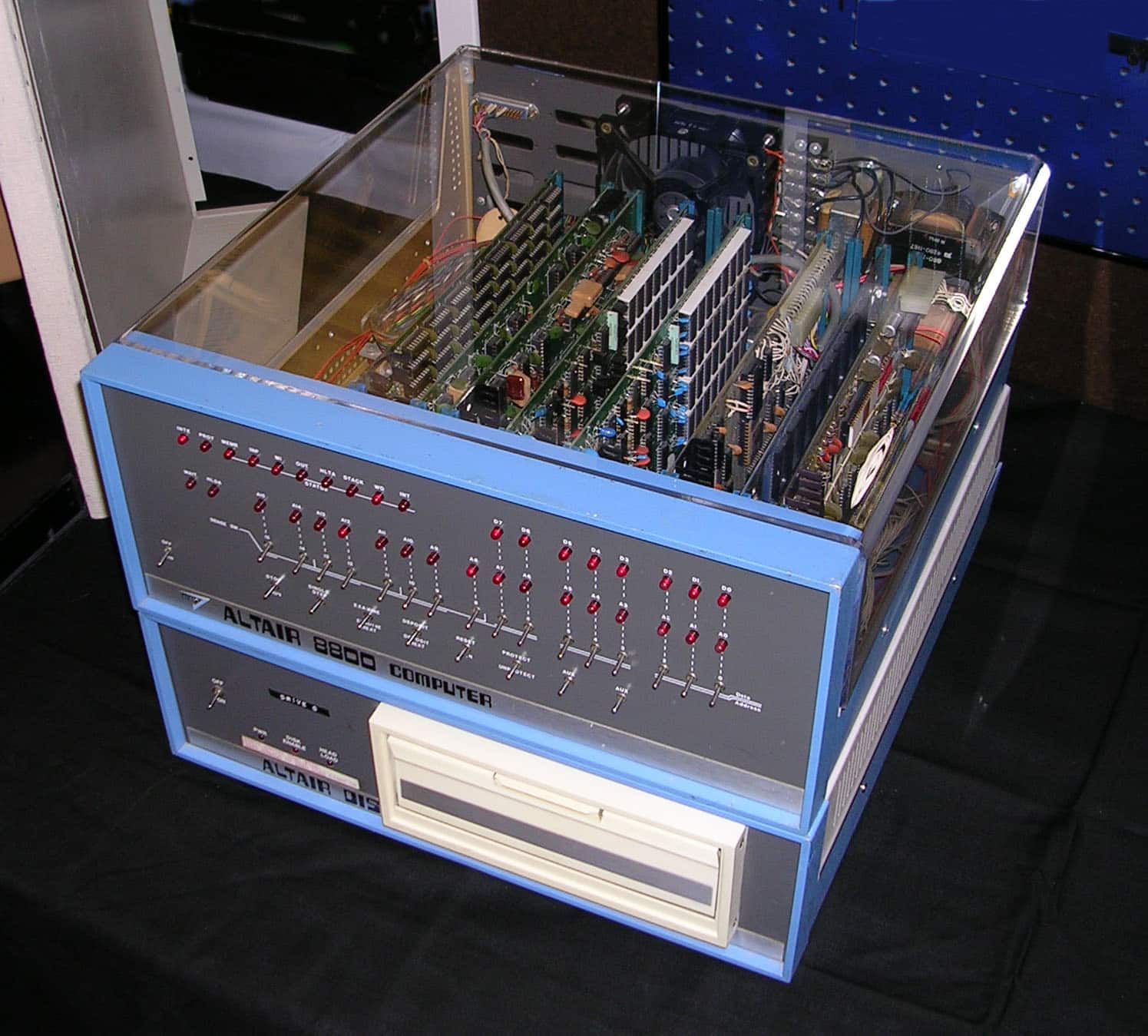
Altair 8800 Computer – By Swtpc6800en:User:Swtpc6800 Michael Holley – Transfered from en.wikipedia, Public Domain, Link
BASIC
BASIC stands for Beginners’ All-purpose Symbolic Instruction Code. It is a family of general-purpose, high-level programming languages designed in 1964. In the 1960s, computers were big mainframe machines that occupied an entire room. They overheated often, and hence, needed powerful air-conditioning systems to keep them from overheating. Computer operators gave instructions to these computers through punch cards. So, every new computer application required writing a new piece of software. Therefore, only mathematicians and scientists learned to code. But BASIC was more user friendly and easy to learn. This motivated computer hobbyists, even from fields other than science and mathematics, to learn to code. As a result, the scope of computers expanded rapidly. However, until 1975, BASIC was only used in big Mainframe computers and not in microcomputers.
Creates BASIC for Altair 8800, a microcomputer
Therefore, when Allen and Bill told the president of MITS that they had written a version of BASIC for Altair 8800, they captured his interest. So, he told them that he would like to see it. However, Allen and Bill hadn’t actually written any code. They just wanted to see if the company would be interested in purchasing a version of BASIC for microcomputers.
So, when the president of MITS asked to see the code, they started working day and night to write the code. But they didn’t have an Altair 8800 to test their code on. Hence, they simulated it on other computers in Harvard’s computer lab.
Bill started working very hard to finish the code. Bill would code the entire day in Harvard’s computer lab, sleep at the computer, wake up the next day and pick up programming at the exact place where he left it off the previous day. For working several days like this, they developed a newer version of BASIC. However, they still did not know if it would work on Altair. But despite their doubts about their new software, Allen flew to Albuquerque in New Mexico to show it to MITS. To his surprise, when he tested it on an Altair 8800, the software worked perfectly. So, they sold it to MITS for $3000 while retaining its copyright.
Microsoft
Founds Microsoft
Now, Allen and Bill knew that programming for microcomputers had a bright future. So, Allen persuaded Bill to drop out of college. Together, they moved to Albuquerque and established Microsoft in 1975. The name, which was the short form of Microcomputer software, initially had a hyphen between ‘Micro’ and ‘soft.’ But the hyphen was removed later.

MITS, the company Allen and Bill wrote code for, was soon acquired by a bigger company. But that did not stop Allen and Bill from writing software. They continued writing software for other start-ups like Apple, Tandy Corp, and Commodore. In 1979, they moved to Seattle.
Creates MS-DOS
Soon, Microsoft started to become famous for its computer software. So, IBM, the largest computer maker at that time, came knocking on Microsoft’s doors. They wanted to know if Bill had an operating system that they could use for their first microcomputer, the IBM PC. An operating system acts as an interface between the user and the computer’s hardware. By managing both the hardware and the software, it lets the user communicate with the computer even if he/she doesn’t know the computer’s language.
When IBM asked Bill if he had an operating system for their microcomputer, Bill immediately answered that he had one. But the truth is, he didn’t have any functioning operating system. So, he quickly bought an operating system from another person in Seattle for $50,000. Then he developed it into MS-DOS (Disk Operating System) and sold it to IBM. Using DOS, users could navigate, open, and edit files on their computer through a command line instead of a Graphical User Interface like Windows.
Becomes a copyright guru
Microsoft, however, retained the right to license the software to other companies. After all, writing software costs time, effort, and money, and Bill Gates thought that people should pay to use the software.
Until then, customers either wrote their own software, or the software came preinstalled with the hardware. So, IBM thought people would only pay for the hardware and never pay for the software. Therefore, they didn’t have a problem with Microsoft selling MS-DOS to other companies. However, just like Bill had anticipated, other companies, like Compaq, also purchased MS-DOS. Like IBM, they decided that purchasing an existing Operating System like MS-DOS would be cheaper than creating their own Operating System. So, MS-DOS became the standard operating system for the computers of that era. As a result, Microsoft’s sales rose from $7.5 million in 1980 to $16 million in 1981.
Allen leaves Microsoft
Thus, by 1981, Microsoft had become a familiar name across the USA, if not the entire world. However, two years later, when the company was making huge profits, Allen, the man who played a vital role in Microsoft’s formation and success, left the company. But why would he leave the company when it was making so much profit, after all the things he had done to make it grow?
In 1982, Allen was diagnosed with Hodgkin’s lymphoma, a type of uncommon cancer that develops in the lymphatic system. Thus, naturally, his productivity in the company reduced. But Bill got frustrated at his lack of productivity. So, Bill and his new lieutenant plotted to reduce Allen’s ownership stake in the company by issuing stock options to themselves and other shareholders. However, fortunately, Allen overheard them talk. So, disheartened, he left Microsoft a year later.
After Allen left the company, Microsoft became a Multinational company, establishing offices in Great Britain and Japan. By 1983, almost 30% of all computers in the world were running its software.
Bill Gates and Steve Jobs
In the late 1970s, when Microsoft was slowly rising to fame, Bill met Steve Jobs. Just like Bill, Steve was also a young man with high aspirations.
Just one year after Bill and Allen founded Microsoft, Steve and his friend Wozniak founded Apple. As Steve and Wozniak developed Apple computers, they wanted to offer a revolutionary graphical user interface for their users. To achieve their goal, they decided to create visual programs with which their customers could perform their daily business activities.
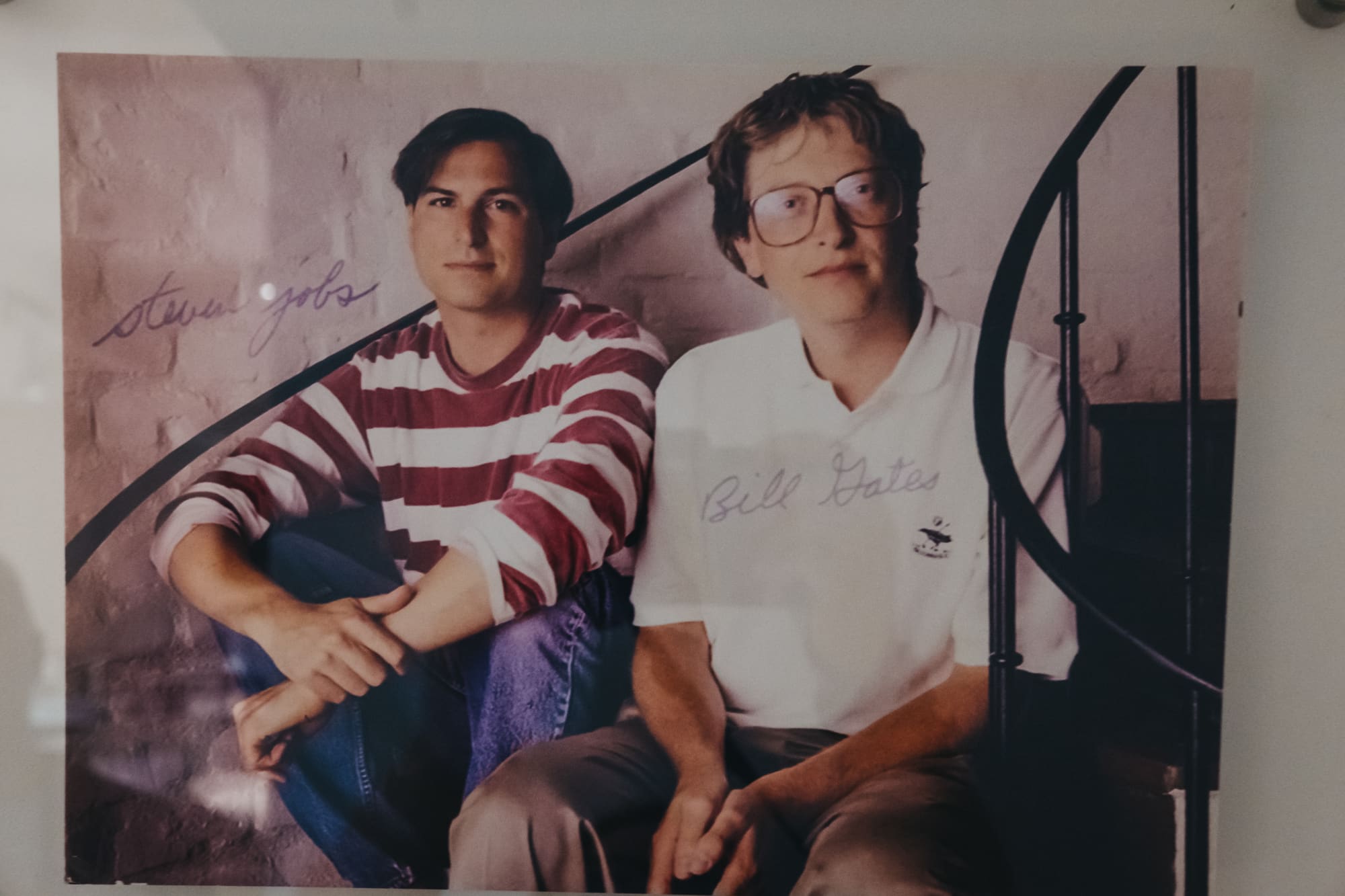
A signed portrait of Steve Jobs and Bill Gates
Creates Word and Excel for Apple
At that time, Microsoft was a major computer software maker. Therefore, in the early 1980s, Steve Jobs made a deal with Microsoft to create software for Apple. The deal was that Microsoft would make a visual program for organizing data and doing calculations (Excel), a visual program for typing and saving documents (Word), and a version of BASIC, the easy-to-use programming language, for the Apple Macintosh computer.
After the deal was made, Bill went to Apple’s headquarters to demonstrate the software Microsoft had created. There, he saw Apple’s Operating system, which used a graphical user interface driven by a mouse and displayed text and images on the screen. On the other hand, Microsoft’s operating system DOS was driven by a keyboard and could only display text on the screen. Bill instantly realized that Apple’s graphical user interface would become more appealing to the end-users when compared to DOS.
A Bluff to retain customers
Bill was afraid that, once Apple’s Macintosh computers were released to the public, DOS would become obsolete, and Microsoft would lose its customers. So, Bill made advertisements claiming that Microsoft was developing an operating system that uses a similar graphical user interface as Apple. However, Microsoft did not have any such program. It was only a bluff. However, as a marketing tactic, it worked very well. It encouraged Microsoft’s customers to wait for a few months to get their hands on Microsoft’s new graphical user interface running on their IBM or Compaq computers, instead of purchasing a completely different computer like Apple’s Macintosh. Bill called this new operating system ‘Windows.’
When Steve Jobs heard about Windows, he was outraged. So, he called Bill to Apple’s headquarters and accused him of stealing Apple’s ideas. However, Steve Jobs himself came up with the idea of the Graphical User Interface after being inspired by Xerox. So, he told Steve Jobs, “Well, Steve, I think there’s more than one way of looking at it. I think it’s more like we both had this rich neighbor named Xerox and I broke into his house to steal the TV set and found out that you had already stolen it.” Steve Jobs even publicly said, “They just ripped us off completely, because Gates has no shame.” In reply, Bill said, “If he believes that, he really has entered into one of his own reality distortion fields.” Thus, the conflict between two great men started, and with it the competition between two huge companies.
Microsoft and Apple
In 1985, due to internal conflict, Steve Jobs left Apple. The man who took over the Mac division from Steve Jobs was Jean-Louis Gassée. Only one year earlier, Apple’s first Macintosh computer had gone on sale. Two-thirds of software sales for Mac at that time came from Microsoft’s software. So, Bill Gates recommended to Apple‘s CEO John Sculley that Apple should license its Macintosh operating system to other manufacturers.
By doing so, Apple could establish Macintosh’s operating system as the standard interface for personal computers, just like Microsoft had made DOS the standard operating system a few years before by licensing it to outside manufacturers. Thus, Apple would not just make money when someone bought its computer, but also when someone bought an IBM or Compaq computer with Macintosh’s operating system. Even though it would replace DOS as the standard operating system, Bill would still make a lot of profits from the sales of Microsoft’s software for Mac.
After a lot of consultation with his licensees, Apple’s CEO Sculley decided that such a move would benefit Apple too. However, when the proposal came to Gassée’s desk, he rejected it. He believed that Apple’s Macintosh Graphical User Interface should be exclusive to Apple’s computers. He reasoned that Macintosh was so superior to other computers that they would make huge profits just by selling them. They need not depend on software sales to keep Apple in the market because their hardware was the best. Moreover, he did not trust Bill. He thought that Bill might have a secret plan to sabotage them.
The marketing genius of Bill Gates
Since his proposal was rejected, Bill’s dreams to capitalize on Apple’s success failed. This meant that Macintosh’s operating system would only run on Apple computers. If an IBM or Compaq user wanted to experience Apple’s superior graphic interface, he/she would have to buy Apple’s computer. There was no other way out. But realizing this fact, Bill sensed a huge opportunity to become the leader in the market if he released an operating system with a graphical user interface that could become the standard operating system for all the computers in the future.
Windows 1.0 – Slow and Cumbersome
So, in 1985, nearly two years after Bill made the public announcement about Windows, Microsoft launched Windows 1.0. But contrary to Bill’s expectations, Windows wasn’t a huge success. When it was launched, Windows was pretty slow and cumbersome. Other operating systems in the market, besides Macintosh’s operating system, were far better than Windows 1.0. So, Windows 1.0 did not become popular among computer users. However, it led to a fight with Apple.
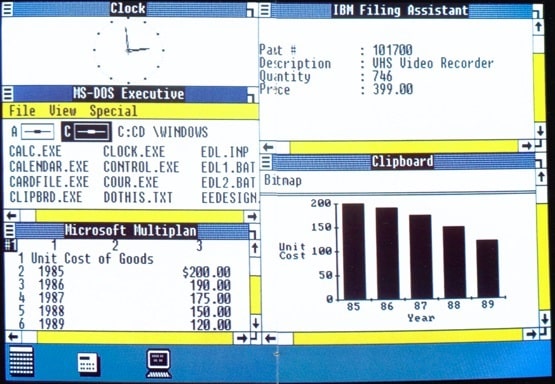
Windows 1.0 (Picture credits)
The conflict between Apple and Microsoft
When Sculley saw Windows, he got infuriated. Some of the elements in Windows resembled Apple. So, he threatened to sue Windows. But Bill had licensed the Graphical User Interface from Xerox. So, in return for Apple’s threat, Bill threatened to stop creating software, including Word and Excel, for Mac. However, Apple’s sales at that time were not that great. Even though they expected to sell 50,000 Macs/month, they sold only 20,000 Macs/month by the end of 1985. In addition to that, two-thirds of the software sales for Mac came from Microsoft’s software. So, breaking their partnership was not beneficial for either of them. Moreover, Windows was not even a big competitor to Mac’s Graphical User Interface because it wasn’t that great.
So, they came to an agreement. Microsoft agreed to continue creating software for Apple. They also agreed not to sell Excel to any other manufacturer for two years. In return, Apple agreed to license Macintosh’s visual displays to Microsoft for use in software derived from Windows 1.0. After the deal was made, Sculley restructured the company. Soon, Apple’s sales began to improve. In 1987, within two years after signing the deal, Apple’s net income doubled. So, Sculley came to be lauded by everyone for the advantageous deal and for turning Apple into a profitable company.
In 1986, one year after they signed the deal, Microsoft went public. The move was a brilliant strategy. It raised $61 million, and Bill became one of the richest people in the USA overnight.
Windows 2.0 – Huge Improvement, but looks similar to Macintosh’s GUI
Two years later, Microsoft launched Windows 2.0. Windows 2.0 was a huge improvement to Windows 1.0.
In Windows 1.0, users could open different applications at the same time. Each application would open in a separate window. But the interface was tiled, and there was no gap between different opened windows. Moreover, windows couldn’t overlap each other or be stacked on top of each other. So, if a user wanted to move a window, he had to move it to a place occupied by another window, much like playing a jigsaw puzzle or minimize it. Moreover, it required too much hardware resources, and hence, was too slow. It had primitive applications like a text editor, notepad, clock, and paint.
However, Windows 2.0 was far superior to Windows 1.0. In Windows 2.0, the interface wasn’t tiled anymore. There was a gap between different opened windows, and they could overlap each other. Resized windows could be moved across the screen. It was also faster. But more importantly, it had Microsoft Word, Microsoft Excel, and Aldus PageMaker, which helped create documents for print publications. Moreover, other companies also started producing applications compatible with Windows 2.0. One year later, Microsoft also bundled Microsoft Word and Microsoft Excel into a single suite called Microsoft Office. This made Windows 2.0 even more attractive.
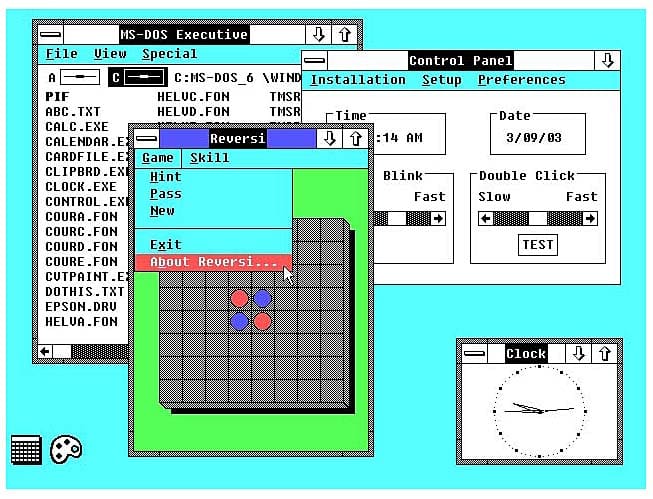
Windows 2.0 (Picture credits)
But despite all its improvements, Windows 2.0 resembled Macintosh’s Graphical User Interface more than Windows 1.0. Sculley, Apple’s CEO, believed that the deal they had made gave Microsoft permission to use Macintosh’s visual displays only in Windows 1.x and not in its later versions. So, Apple filed a lawsuit against Microsoft.
The Lawsuit
The lawsuit could have potentially ended Microsoft’s future. Had the court ordered Microsoft to perform any changes, it could have made its products incompatible with many computers and made Windows undesirable to its customers. Moreover, it could have strained the business of many computer manufacturers who delivered Windows as the standard operating system. But luckily, the case, which scared Microsoft and its clients for five years, was decided in favor of Microsoft in 1993. The court declared that the license granted by Apple covered the use of graphical displays.
The Rude boss
But despite the success of the court case, Bill Gates was never complacent. He couldn’t be completely secure. So, he involved himself in all sides of software development, from product development to corporate strategy. While deciding any move that his company should make, he often analyzed all the possible scenarios of what could go wrong. Moreover, he expected his employees to be as skilled as him and have the same dedication to Microsoft. So, he often challenged them to find out how confident they were of their own ideas. If someone went unprepared to Bill, he might fire back at him/her telling that his/her idea was the stupidest thing he had ever heard. While it was a brilliant strategy to make his employees improve their skills and be confident of their own ideas, it also made Bill a person difficult to work with.
Microsoft, the Bully
While Bill was gaining a reputation as a rude boss within his company, outside the company, he came to be known as a ruthless competitor who would do anything to make Microsoft win over its competition. To understand how Microsoft became a ruthless competitor, we should look at how Microsoft bullied Netscape.
Netscape and its internet browser
Just like Microsoft and Apple revolutionized the computer market by creating Graphical User Interface, Netscape is a company that revolutionized internet browsing. In 1993, the National Center for Supercomputing Applications (NCSA) at the University of Illinois developed Mosaic, the user-friendly internet browser. It was a simple graphical browser with a point-and-click interface. It enabled users to upload documents and create hyperlinks to other documents. By following these links, one could travel around the online world and access a document at the other end of the world. It could run on Apple computers, as well as computers running on Windows and Unix. Moreover, it was free for non-commercial use. So, it made the internet easily accessible to normal people and led to the internet boom of the 1990s.
Inspired by Mosaic’s success, Marc Andreessen, the man who spearheaded its development, left NCSA and, along with James H. Clark, founded his own company called Mosaic Communications Corp. The company was eventually renamed Netscape communications corporation. In 1994, Netscape released Navigator, its new internet browser with extended functionalities. It had several improvements over Mosaic. It also gave its users the option to use the software freely before purchasing it. Moreover, it had a plug-in interface, allowing independent developers to create modules to extend its functionalities. This pushed it in the direction of an ‘open-source’ browser. As a result, Netscape Navigator quickly became people’s favorite browser. Within one year of its launch, almost eight million people downloaded it. Consequently, Netscape became one of the leading software makers in the world.
Microsoft destroys Netscape
Netscape’s rise to prominence in the software market threatened Microsoft. Moreover, Netscape’s open-source approach led people to believe that it may even replace Operating Systems like DOS and Windows in the future. So, in 1995, Microsoft launched an urgent campaign to enter the internet market. It licensed the Mosaic browser code that Andreessen and his colleagues in the NCSA had written. Then it modified it and released it as internet explorer.
Microsoft offered internet explorer free of cost, even for commercial purposes. However, it wasn’t as good as Navigator. So, it pressurized computer makers and Internet Service Providers to offer internet explorer instead of Navigator to their customers. Sometimes, it even forced computer makers to offer internet explorer as a condition to sell them Windows licenses, even if it meant that Microsoft would lose millions of dollars. And starting from 1996, it started to integrate Internet Explorer into Windows 95 directly. If a user tried to uninstall internet explorer and install another browser like Navigator, the computer could even slow down.
In January 1996, 80% of all browser users used Navigator. But Microsoft’s campaign had a devastating effect on Netscape as its share in the browser business dropped. By November 1997, its share had dropped to 55%. During the same time, Internet Explorer’s share in the browser business rose from 5% to 36%. Finally, in 1998, unable to cope with the pressure from Microsoft and its other competitors, Netscape made Navigator free. It even made its source code available to developers. Eventually, Netscape was acquired by another big company, and its source code was used by independent developers to create Firefox.
Microsoft faces trial
But Microsoft’s bullying did not end with Netscape. During its launch of Windows 95 and even afterward, Microsoft pressurized many small companies to kill their products and tried to take over their innovation. Even big companies like IBM, Apple, and Intel were not spared.
Thus, Microsoft allegedly created a monopoly by suppressing its competitors. But it did not go unnoticed by the Federal Trade Commission. So, throughout the 1990s, Microsoft faced a string of investigations from the Justice Department. At one point, the company even faced a possible breakup. However, Bill claimed that whatever he did had made the services cheaper for his customers. Moreover, he created advertisements and made public appearances that attracted the public’s sympathy. Eventually, Microsoft was able to make a settlement with the federal government and avoid a breakup.
Bill Gates becomes the richest person in the world
By the late 1990s, Microsoft had a solid line of products like Windows, Office, and Internet Explorer. Moreover, thanks to the monopoly it had created, Microsoft was able to dominate the software market. So, throughout the 1990s, Microsoft’s shares continued to soar. As a result, Bill Gates, who owned a lot of these shares, became extremely rich. So, in 1995, when he was just 39 years old, Bill Gates became the richest person in the world. His net worth at that time was $12.9 billion.
When Microsoft launched Windows, Bill Gates envisioned a world where every house owned a computer, and that computer ran on Windows. In 1999, he came close to realizing the latter part of his dream. By 1999, almost 90% of the world’s desktop computers were running on Windows. That year, Microsoft made $19.7 billion in sales, and Gates’ net worth increased to $90 billion.
Microsoft’s employees become filthy rich
But Bill Gates is not the only one who profited from Microsoft’s success. In the 1980s and 1990s, many employees accepted Microsoft’s stocks as a part of the payment for their 60-hour workweeks. So, by 1996, when Microsoft’s stocks increased more than a hundredfold within ten years, they became rich too.
According to Richard S. Conway Jr., an economist from Seattle whom Microsoft hired to study the impact it had on Washington State, there could have been 10,000 millionaires and three billionaires among Microsoft employees by the year 2000. These figures only increased one year later, when Microsoft launched the original Xbox gaming system and entered the gaming industry.
Bill Gates stops working full-time at Microsoft
After making Microsoft a global leader in software creation, in 2000, Bill Gates stepped down from his position of CEO. His Harvard friend Steve Ballmer succeeded him as Microsoft’s CEO. Bill Gates then took the role of a chief software architect and worked in Microsoft until 2008. In 2008, he quit his full-time job at Microsoft but retained the position as the board chairman. In 2014, he stepped down from that position too but retained the position as a board member. After that, he started working as a technology advisor.
Even though Bill Gates might have earned a reputation as a rude boss and a fierce competitor, there is another side to him as well. He is also one of the biggest philanthropists of the twenty-first century. Bill Gates and his wife, Melinda Gates, have contributed a lot of money for charitable causes.
Charity
Bill Gates and Melinda Gates
In 1987, 23-year-old Melinda Ann French joined Microsoft as a product manager. Three weeks after joining, she went to New York for work. There, at a dinner event, she met 32-year-old Bill Gates, who sat next to her. After dinner, Bill asked her to go dancing with him and his friends. However, she had already made plans with her friends. So, she turned him down.
After a few months, they met at Microsoft’s parking lot. Bill struck up a conversation with her and asked her to go on a date with him after two weeks. However, his tendency to plan everything far ahead of time turned her off since she didn’t even know what she would be doing after two weeks. So, she turned him down once again, citing that he wasn’t spontaneous enough for her. So, trying to be spontaneous, Bill called her after one hour and asked her for a date again. This time, she agreed. It was one of the many dates they would go on, before starting a relationship.
A year into their relationship, both of them found out that they love each other. So, Melinda wanted to get married to him. But Bill wasn’t ready to commit yet. Moreover, he didn’t know if he could run a family and a business at the same time. So, he made a list of pros and cons of marrying Melinda and eventually ended up marrying her in 1994, when he found that the pros outweighed the cons. Bill and Melinda Gates have three children.
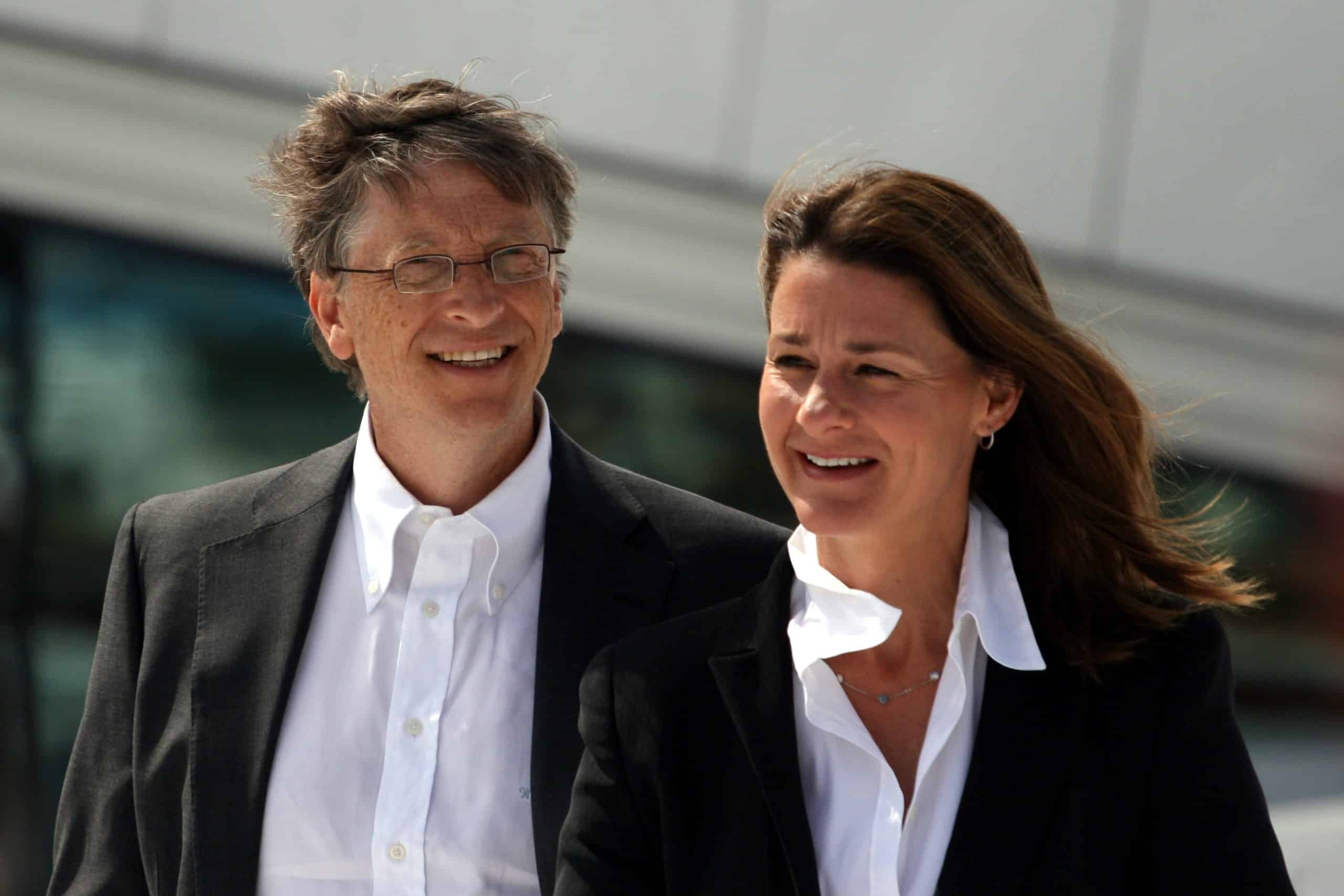
A picture of Bill and Melinda Gates in 2009 – By Kjetil Ree – Own work, CC BY-SA 3.0, Link
Bill Gates starts contributing to charity
In 1994, the couple, along with Bill Gates’ father, established the William H. Gates Foundation. The goal of the charity was to promote global health and improve the Pacific Northwest community. Two years later, their first child, a daughter, was born. So, Melinda resigned from Microsoft to spend time with her daughter and focus on charity. One year later, in 1997, they founded the Gates Library Foundation. The charity donated computer hardware and software to public libraries to help them get access to the internet so that low-income communities in North America can access the internet. Eventually, it was named the Gates Learning Foundation.
The Bill and Melinda Gates Foundation
In 2000, these two charities were merged, and the Bill & Melinda Gates Foundation was established. Its priorities were to improve global health, global education, and aid global development. In 2006, Warren Buffet pledged his company Berkshire Hathaway’s stock worth $3 billion to the foundation.
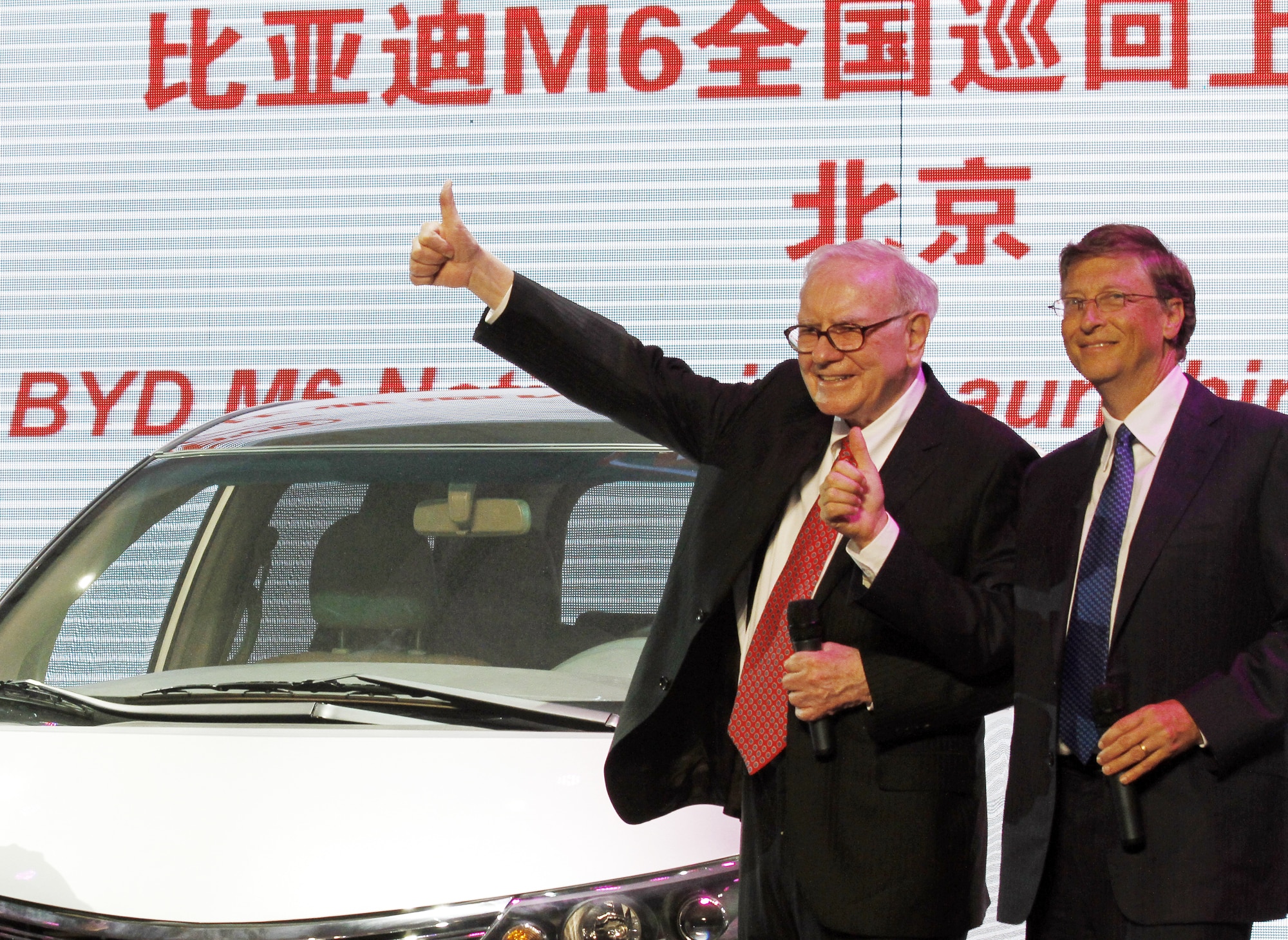
Bill Gates and Warren Buffet
In 2008, Bill Gates quit his full-time job at Microsoft as a chief software architect to focus on the Bill & Melinda Gates Foundation. As of 2019, the Bill & Melinda Gates Foundation is the largest non-profit organization in the world, with assets worth $50.7 billion. Every year, it donates $1 billion for important causes.
Today, the foundation focuses on eradicating hunger and poverty. It funds researches that try to produce rice enriched with nutrients. It provides grants to organizations that research issues which affect developing countries, like sanitation, hygiene, water problems, etc. The Bill and Melinda Gates foundation fights to reduce death rates and inequalities in health in developing countries by focusing on improving nutrition; maternal, newborn, and child health; vaccine delivery, and emergency response for diseases that cause widespread death in developing countries. The charity funds projects that research on improving health and medical facilities in developing countries. It works with governments to raise public awareness of its work and advocates tobacco control to people. It strives to reduce homelessness in families. The foundation has also funded the tuition fees of 20,000 college students and installed 47,000 computers in 11,000 libraries across the USA.
Facts you probably didn’t know:
- Even though Bill Gates and Microsoft have become synonymous today, the company wouldn’t be what it is today if not for Paul Allen. It was Allen who wrote most of Microsoft’s first program. According to veterans, he also played a very big role in Microsoft’s big successes – DOS, Windows, and Word. Even the company’s name, Microsoft, was actually Allen’s idea.
- By the year 2007, Bill Gates and his wife Melinda Gates became the second-most generous philanthropists in America.
- In 2007, Bill and Melinda planned to donate 95% of their wealth to charity eventually. Ten years later, they announced that they would leave $10 million to each of their three children and give the remaining 99.96% of their wealth to charity.
- Forbes named Bill Gates the fourth most powerful person in the world in 2012.
- Bill Gates’ parents were often involved in philanthropy and community work. His mother, Mary, is a firm believer of the idea that “To whom much is given, much is expected.” She instilled this belief in her children. His parents’ upbringing played a big role in Bill Gates’ philanthropic works today.
- Bill Gates is color blind.
- He never completed his Harvard degree. But he has been conferred many honorary degrees.
- Bill Gates had held the Forbes’ title of the richest person in the world for 19 years between 1995 and 2017.
Bill Gates predicts the occurrence of a global pandemic
Speaking at a TED talk in 2015 during the Ebola outbreak, Bill Gates predicted that the next event that would cause millions of deaths would not be a nuclear war but a global pandemic. Since we have invested a lot in the research of nuclear weapons and how to stop them, a nuclear war might not kill millions of people. However, after analyzing the way the world dealt with Ebola, he realized that we don’t have a proper system to counter a pandemic. He also explained that we were lucky that Ebola couldn’t spread by air, and by the time it became contagious, people were already bedridden. So, it didn’t spread rapidly. However, if a virus could spread through the air, like the Spanish Flu of 1918, we wouldn’t be able to respond to it. So, he warned that the world is not prepared for the next pandemic. Watch the TED Talk here.
Why was Bill Gates successful?
Bill Gates had never divulged his IQ. But the fact that he scored 1590 out of 1600 in the SAT exam in 1973 means that he has an IQ of roughly 151.45. He scored 99.38% in that exam. Thus, he is extremely smart. On one side, he is a geek and a very good programmer. But on the other side, unlike his other Silicon valley counterparts, he is also a hard-core, high risk-taking businessman driven by future foresight of the market. This combination made it possible for him to see what his competitors could not. At a time where everyone was focusing on selling software, Bill Gates was focusing on setting standards. These standards he set, first using MS-DOS and later using Windows, improved the computer industry while enabling him to dominate the market and destroy his competition. This made Bill Gates extremely successful.
What to read next?
If you liked reading this biography of Bill Gates, you will love the following blog posts too:
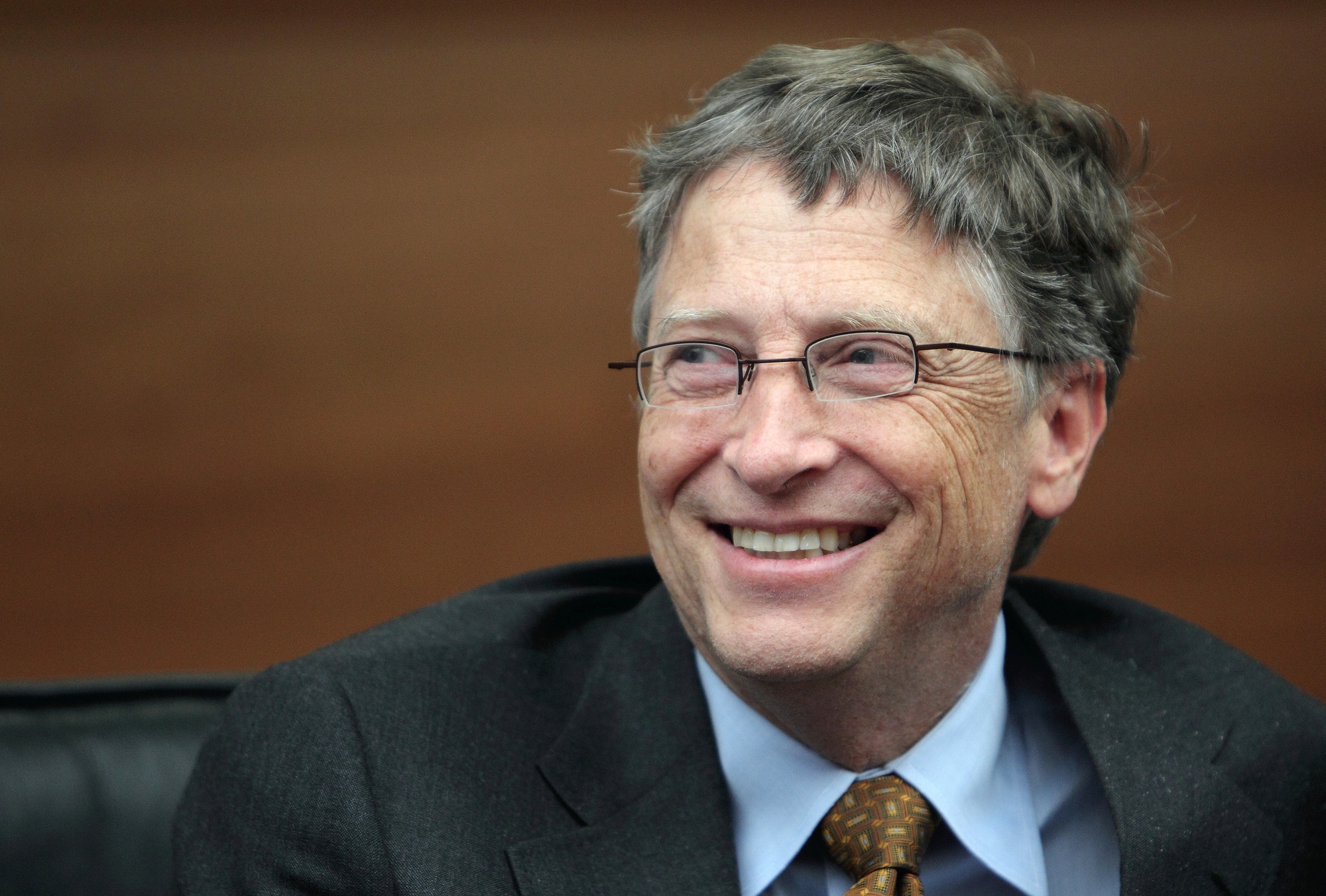

Leave a Reply